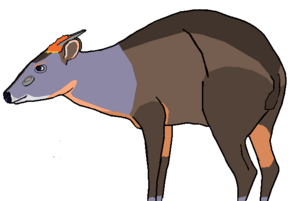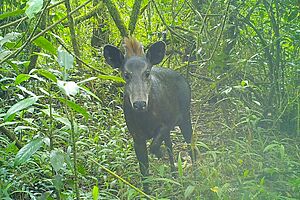Abbott's duiker facts for kids
Quick facts for kids Abbott's duiker |
|
|---|---|
 |
|
| Conservation status | |
| Scientific classification | |
 |
|
| Distribution of Abbott's duiker |
The Abbott's duiker (Cephalophus spadix) is a type of small antelope. It is also called minde in Swahili. These duikers are quite large for their kind. They live in forests, but only in a few places in Tanzania. This animal is very rare. The first photo of an Abbott's duiker in the wild was taken in 2003.
Contents
Meet the Abbott's Duiker
Abbott's duikers are about 65 cm (26 in) tall at the shoulder. They weigh around 55 kg (121 lb). Their fur is a shiny, dark brown color. It is lighter on their belly.
Their face is a lighter gray. They have a big red tuft of hair on their forehead. Their horns are thin and short, about 8 to 12 cm (3.1 to 4.7 in) long.
What Do They Eat?
Abbott's duikers are very shy animals. They are also mostly active at night. This means we don't know much about them. Scientists have seen them eating leaves in the forest. They also eat plants in open areas of the forest. They might also eat fruits, flowers, and moss.
Sometimes, duikers even eat small animals. An Abbott's duiker was once seen with a frog in its mouth!
Who Hunts Them?
Even though they are secretive, Abbott's duikers can be hunted. Young duikers might be caught by African crowned eagles. Pythons might also hunt them. Adult duikers can be prey for leopards. In some places, lions and spotted hyenas might also hunt them.
Where Do They Live?
Abbott's duikers live only in Tanzania. You can find them in places like the Eastern Arc Mountains. They also live near Mount Kilimanjaro and in the Southern Highlands. They live in small groups in these areas.
They mostly live in wet forests and swamps. These places are usually high up, between 1,700 and 2,700 meters above sea level. Sometimes, they can even go as high as 4,000 meters.
Daily Life of a Duiker
Abbott's duikers are nocturnal. This means they are active at night. During the day, they rest in thick bushes. They make regular paths through the plants. This can make them easier to find. If they feel in danger, they usually try to run away. But if they have no escape, they have been known to fight off dogs.
How Are They Doing?
There are not many Abbott's duikers left. Experts think there are fewer than 1,500 of them in the wild. There are none living in zoos or other places where they are cared for by humans.
They face two main threats. One is habitat destruction, which means their forest homes are being cut down. The other threat is poaching, which is illegal hunting.



